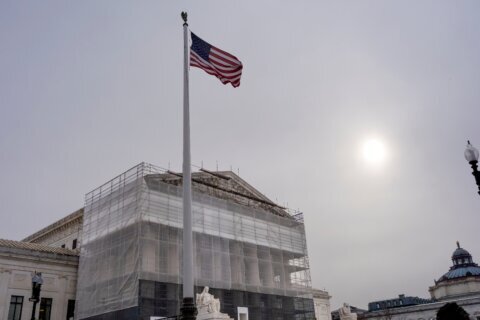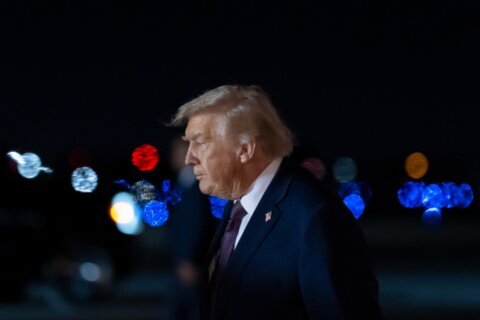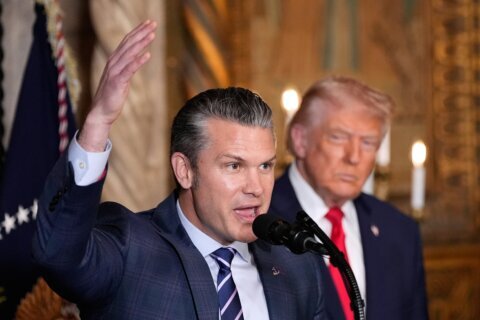Revealing an airstrike over “beautiful” chocolate cake. A trespasser from China carrying flash drives and electronics. Cellphone photos of the “nuclear football” briefcase. And now, classified documents recovered during an FBI search.
Mar-a-Lago, the stone-walled oceanfront estate Donald Trump labeled the “Winter White House,” has long been a source of headaches for national security and intelligence professionals. Its clubby atmosphere, sprawling guest-list and talkative proprietor combined into a “nightmare” for keeping the government’s most closely held secrets, one former intelligence official said.
Now, the 114-room mansion and its various outbuildings are at the center of a Justice Department investigation into Trump’s handling of presidential material. After an hours-long search of the property last week, FBI agents seized 11 sets of documents, some marked as “sensitive compartmented information” — among the highest levels of government secrets. CNN reported Saturday that one of Trump’s attorneys claimed in June that no classified material remained at the club — raising fresh questions about the number of people who have legal exposure in the ongoing investigation.
In many ways, Trump’s 20-acre compound in Palm Beach, Florida, amounts to the physical embodiment of what some former aides describe as a haphazard-at-best approach by the former President to classified documents and information.
“Mar-a-Lago has been a porous place ever since Trump declared his candidacy and started winning primaries several years ago,” said Aki Peritz, a former CIA counterterrorism analyst. “If you were any intelligence service, friendly or unfriendly, worth their salt, they would be concentrating their efforts on this incredibly porous place.”
When Trump departed office in January 2021, it was Mar-a-Lago where he decamped, sore from a loss he refused to acknowledge. The club, with its paying members and large oil paintings of Trump as a younger man, was a welcome refuge.
It was also the destination for dozens of cardboard boxes, packed in haste in the final days of his administration and shipped in white trucks to Florida. People familiar with Trump’s exit from Washington said the process of packing was rushed, in part because the outgoing President refused to engage in activities that would signal he’d lost the election. When it became clear he would need to leave the White House, items were quickly stowed away in boxes and shipped south without a clearly organized system.
“Trump kept a lot of things in his files that were not in the regular system or that had been given to him in the course of intelligence briefings,” said John Bolton, Trump’s former national security adviser. “I can easily imagine in the last chaotic days at the White House, since he didn’t think he was going to leave until the last minute, they were just throwing things in boxes, and it included a lot of things he had accumulated over the four years.”
Some boxes, including some containing classified documents, had ended up at the club after Trump’s presidency concluded. When federal investigators — including the chief of counterintelligence and export control at the Justice Department — traveled to Mar-a-Lago in June to discuss the classified documents with Trump and his lawyers, they voiced concern the room wasn’t properly secured.
Trump’s team added a new lock onto the door. But FBI agents returned to Mar-a-Lago last week to execute a search warrant on the property that identified three possible crimes: violations of the Espionage Act, obstruction of justice and criminal handling of government records.
The items taken away after Monday’s search included a leather box of documents, binders of photos, “miscellaneous top secret documents” and “Info re. President of France,” according to the search warrant. Trump and his allies have claimed he used his presidential prerogative to declassify the documents before leaving office, though haven’t provided any evidence of a formal process taking place.
“My only surprise was that there wasn’t even more taken to Mar-a-Lago,” Bolton said.
A habit of defying norms
Last week was not the first time federal intelligence officials worried about how Trump was keeping the government’s secrets. Nearly as soon as he took office, Trump demonstrated a willingness to flaunt protocols for guarding sensitive information.
In 2017, he spontaneously revealed highly classified information about an Islamic State plot to a group of Russian visitors, including the foreign minister, that the US had received from Israel. It caused deep anger in both countries’ intelligence services.
When he was briefed by intelligence officials in 2019 about an explosion in Iran, he later tweeted out a highly classified satellite photo of the facility — despite having heard officials’ concerns beforehand that doing so could reveal American capabilities.
Trump preferred to receive intelligence updates electronically, according to his third chief of staff Mick Mulvaney, though he sometimes asked to keep physical documents from classified briefings.
“From time to time the President would say, ‘Can I keep this?’ But we had entire teams of people to make sure those documents didn’t get left behind, didn’t get taken up to the residence. He would use them. That was his right as the President of the United States,” Mulvaney said.
Still, the tracking of records was not a priority for Trump, according to several former officials. When he asked to keep sensitive documents, officials sometimes became concerned at what would happen to the material. When he traveled, aides often followed close behind toting cardboard boxes where they’d collected stacks of papers Trump had left behind.
Mixing business with pleasure
At Mar-a-Lago, worries about Trump revealing top government secrets — accidentally or otherwise — were amplified. The facility acts as a pool club, spa, restaurant and clubhouse for its members and their guests; the gold-trimmed Donald J. Trump ballroom can be rented for weddings and other events.
While the Secret Service screens visitors for weapons and checks their names against a list, they are not responsible for protecting secret documents or guarding against potential interference.
Members flocked to Trump’s club when he was in town as President, and rules enacted early in his tenure against taking photos in the dining room were not always strictly followed.
That became evident in February 2017, when Trump hosted the late then-Prime Minister Shinzo Abe of Japan for dinner on the patio. After a North Korean missile launch interrupted the meal, Trump and Abe huddled with their national security aides in full view of other diners, who picked away at wedge salads with blue cheese while snapping photos of the leaders’ impromptu crisis talks.
Later, Trump’s aides insisted he had ducked into a secure room — known as a Sensitive Compartmented Information Facility (SCIF) — to receive updates on the launch, and that he and Abe were simply discussing the logistics for their press statements.
Yet the flood of photos posted to social media by Mar-a-Lago members showed the two leaders poring over documents at their dinner table, along with aides working on laptops and Trump speaking on his cellphone. At one point, staffers used the flashlights on their cellphones to illuminate documents the leaders were reading.
Soon after, some new rules went in effect to limit who could be at the club when Trump was there. Reservations were required two weeks in advance, and new limits were placed on the number of guests that members were permitted to bring.
Trump returned to the Mar-a-Lago SCIF in spring 2017 to discuss launching an airstrike on Syria; at the time, he was hosting Chinese President Xi Jinping for dinner. Later, he said he returned to the table to inform Xi of his decision as they ate the “most beautiful piece of chocolate cake that you’ve ever seen.”
One of the concerns Trump’s aides had at Mar-a-Lago was their relative inability to discern who exactly he was speaking with while he was there. Compared to the White House, with its strict access lists, it was sometimes unclear even to Trump’s senior-most advisers who he’d come into contact with at the club.
Trump’s second chief of staff, John Kelly, worked to limit who had access to Trump at Mar-a-Lago, though there was little expectation he or any other aide would be able to fully restrict the President’s conversations with friends and paying Mar-a-Lago members. Kelly told associates at the time he was more interested in knowing who Trump was speaking with than preventing the conversations from happening.
Kelly also worked to implement a more structured system for the handling of classified material, though Trump’s cooperation in the system was not always guaranteed.
Managing a variety of risks
While at Mar-a-Lago, Trump did not always use his SCIF when viewing classified documents, according to one person familiar with the matter. And his penchant for sharing what he knew with his interlocutors was a source of constant frustration.
“He was a difficult president to support in terms of trying to give him the information he needed while still protecting the way we collected it so that he wouldn’t accidentally or otherwise speak off-the-cuff and mention something that an adversary could use to track down where we had an agent,” said Douglas London, a former CIA counterterrorism official who served during the Trump administration.
London said it was ironic Trump kept classified documents since the former President “wasn’t much of a reader.”
Keeping classified information from Mar-a-Lago’s members was one thing; keeping out potential security threats proved to be its own challenge.
In 2019, a 33-year-old businesswoman from Shanghai was arrested for trespassing on the grounds of Trump’s club. At the time of her arrest, Yujing Zhang had in her possession four cellphones, a laptop, an external hard drive and a thumb drive. Prosecutors said they also found a trove of additional electronics — including a signal detector to detect hidden cameras — and thousands of dollars in cash in her hotel room.
Another Chinese national, Lu Jing, was also accused of trespassing at Mar-a-Lago later that year. Officials said during the incident, Lu was asked to leave by security before returning to the premises and taking photos.
It was never determined what either woman’s motives were in trying to access the club. Lu was found not guilty; Zhang was eventually sentenced to eight months in prison.







